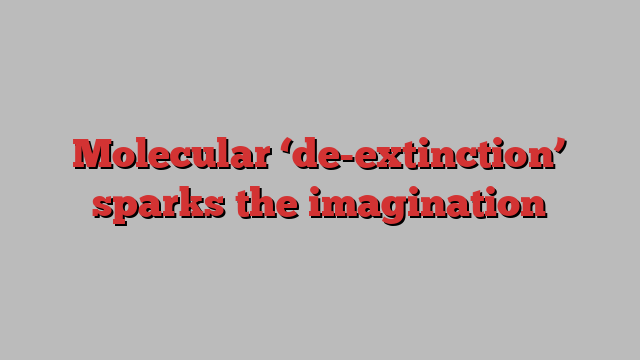
Unlock the Editor’s Digest for free
Roula Khalaf, Editor of the FT, selects her favourite stories in this weekly newsletter.
The writer is a science commentator
It would be a daunting task to look in scientific detail at every molecule around today. But what about studying — and recreating — molecules that no longer exist?
This is the realm of “molecular de-extinction”, a bold new science that seeks to look anew at the genomes of extinct species — not to resurrect vanished creatures but instead to glean whether they contain the blueprints of ancient molecules that could solve modern problems.
A team led by César de la Fuente at the University of Pennsylvania has pioneered the use of artificial intelligence to identify long-lost molecules with antimicrobial potential by scanning the proteins found in woolly mammoths, ancient sea cows and even Neanderthals. Some of the molecules have been synthesised in the lab and found, on early evidence, to have promising antimicrobial properties.
The research is scientifically exhilarating, the bioengineer told me, but there should now be a wider conversation about where it goes next. “It was a watershed moment for me,” de la Fuente said. “I started worrying . . . Is it OK from a bioethical and philosophical perspective for us to synthesise extinct molecules in the lab?”
That appeal is the basis of a short paper written jointly by de la Fuente and Andrew Torrance, a biologist and patent law expert at the University of Kansas, and published last month in Nature Biotechnology. The paper rightly acknowledges that remaking defunct molecules raises fewer ethical qualms than reviving extinct creatures, such as the dodo or woolly mammoth. Nonetheless, the pair write, “the concept of resurrecting molecules from the past [raises] profound ethical questions about our relationship with nature, the limits of human intervention and our responsibilities as stewards of the biological world”.
Recreating extinct compounds, unlike bringing back the dodo or the woolly mammoth, seems scientifically worthwhile. These molecules once helped living things to thrive in past environments. In a constantly changing world, speculating on ancient molecules feels like a wise insurance policy.
The Pennsylvania team originally set out to algorithmically sift through existing proteins for fragments (peptides) with antimicrobial potential. With advances in AI and compute, they scaled up to mine entire proteomes — all the proteins in a genome — of different species. Having logged thousands of molecules with antimicrobial potential lurking in human proteins, they ploughed through the proteomes of Neanderthals and Denisovans, our closest ancestors. But, they reasoned, why stop there? Proteins and peptides are just biological code; any lost code might be useful.
As the team reported in June, they explored the proteomes of about 200 defunct species; 37,000 molecular fragments from extinct organisms were flagged as potentially having broad-spectrum antimicrobial activity. Sixty-nine compounds were synthesised in the lab; several killed off bacteria in Petri dishes and, critically, reduced infections in mice. Among the most potent were mammuthusin-2 from the woolly mammoth, elephasin-2 from the straight-tusked elephant and megalocerin-1 from the giant elk. Some were comparable in efficacy, de la Fuente claims, to polymyxin B, an antibiotic of last resort.
While investors have made approaches, the all-too-familiar lack of market incentives for antimicrobials means de la Fuente and colleagues are also considering the non-profit route to hurry any compounds into clinical trials. If developed, the compounds would be delivered through topical creams or injections, rather than orally or through gene therapy.
One focus of the Nature Biotechnology paper is whether extinct molecules are patentable. Decades of precedent have put naturally occurring substances, such as human and animal genes, beyond the reach of patents, but extinct molecules fall into a grey zone. They no longer occur naturally but, despite only existing when remade in a lab, they are not truly synthetic either.
The future of this research is uncertain on many fronts but it sparks the imagination. Just as ancient migration patterns provide clues to how some diseases emerged, could long-dead organisms reveal adaptations to past climate change, or to pathogens, that we could learn from today? There is also a kind of karmic circularity to molecular de-extinction: modern humans possibly hunted the woolly mammoth and straight-tusked elephant out of existence. And now we are looking to their molecular ghosts for our microbial salvation.